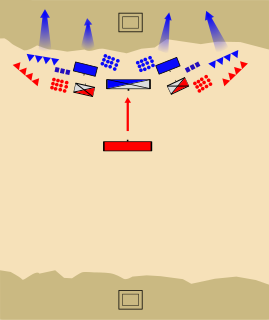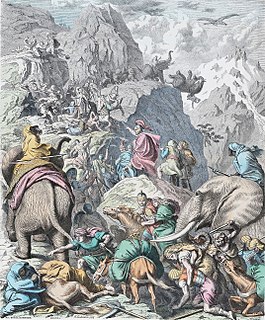Hamilcar Barca or Barcas was a Carthaginian general and statesman, leader of the Barcid family, and father of Hannibal, Hasdrubal and Mago. He was also father-in-law to Hasdrubal the Fair.
Gnaeus Cornelius Scipio Calvus was a Roman general and statesman during the third century BC. He played a major part in the Second Punic War establishing Roman Rule in the east of the Iberian Peninsula and tying up several Carthaginian armies keeping them from reinforcing Hannibal.
Mago Barca, was a Barcid Carthaginian who played an important role in the Second Punic War, leading forces of Carthage against the Roman Republic in Iberia and northern and central Italy. Mago was the third son of Hamilcar Barca, was the brother of Hannibal and Hasdrubal, and was the brother-in-law of Hasdrubal the Fair.

Hasdrubal Barca, a latinization of ʿAzrubaʿal son of Hamilcar Barca, was a Carthaginian general in the Second Punic War. He was the brother of Hannibal and Mago Barca.
The Astures or Asturs, also named Astyrs, were the Hispano-Celtic inhabitants of the northwest area of Hispania that now comprises almost the entire modern autonomous community of Principality of Asturias, the modern province of León, and the northern part of the modern province of Zamora, and eastern Trás os Montes in Portugal. They were a horse-riding highland cattle-raising people who lived in circular huts of stone drywall construction. The Albiones were a major tribe from western Asturias. Isidore of Seville gave an etymology as coming from a river Asturia, identified by David Magie with Órbigo river in the plain of León, by others the modern Esla river.

The Battle of Ilipa was an engagement considered by many as Scipio Africanus’s most brilliant victory in his military career during the Second Punic War in 206 BC.
The Cantabri or Ancient Cantabrians, were a pre-Roman people and large tribal federation that lived in the northern coastal region of ancient Iberia in the second half of the first millennium BC. These peoples and their territories were incorporated into the Roman Province of Hispania Tarraconensis in 19 BC, following the Cantabrian Wars.
The Battle of the Upper Baetis was a double battle, comprising the battles of Castulo and Ilorca, fought in 211 BC during the Second Punic War between a Carthaginian force led by Hasdrubal Barca and a Roman force led by Publius Cornelius Scipio and his brother Gnaeus. The immediate result was a Carthaginian victory in which both Roman brothers were killed. Before this defeat, the brothers had spent seven years campaigning in Hispania, which had limited the resources available to Hannibal, who was simultaneously fighting the Romans in Italy.

The Barcid family was a notable family in the ancient city of Carthage; many of its members were fierce enemies of the Roman Republic. "Barcid" is an adjectival form coined by historians ; the actual byname was Barca or Barcas, which means lightning. See ברק Baraq in Canaanite and Hebrew, برق, barq in Arabic, berqa in Maltese, and similar words in other Semitic languages.
Hanno was a Carthaginian general serving under Mago Barca in the Second Punic War. He is sometimes mistaken for Hanno, son of Bomilcar.
Hasdrubal Gisco, a latinization of the name ʿAzrubaʿal son of Gersakkun, was a Carthaginian general who fought against Rome in Iberia (Hispania) and North Africa during the Second Punic War.

Hasdrubal the Fair was a Carthaginian military leader and politician, governor in Iberia after Hamilcar Barca's death, and founder of Cartagena.

The Battle of Decimomannu or Caralis took place in Sardinia when a Carthaginian army sailed to the island to support a local revolt against Roman rule. The army, led by Hasdrubal the Bald, fought a similar size Roman army under the Praetor Titus Manlius Torquatus in the Fall of 215 BC somewhere between Sestu and Decimomannu, just north of Caralis. The Romans destroyed the Carthaginian army and then scattered their fleet in a sea battle south of Sardinia.
Hanno, distinguished as the son of the suffet Bomilcar, was a Carthaginian officer in the Second Punic War.

The Punica is a Latin epic poem in seventeen books in dactylic hexameter written by Silius Italicus comprising some twelve thousand lines. It is the longest surviving Latin poem from antiquity. Its theme is the Second Punic War and the conflict between the two great generals Hannibal and Scipio Africanus. The poem was re-discovered in either 1416 or 1417 by the Italian humanist and scholar Poggio Bracciolini.

The Battle of Carteia, also known by the modern name Battle of the Guadalquivir, was a battle of the Second Punic War that took place in 206 BC between the forces of Carthage and the Roman Republic. The name "Battle of the Guadalquivir" is anachronistic, since the river's name "el Guadalquivir", from the Arabic al-wadi al-kabir, was not used until the Islamic conquest of Spain over nine hundred years after the battle. The Carthaginian forces were commanded by Hanno and the Romans by Gaius Lucius Marcius Septimus. The battle resulted in a Roman victory.
Viriathus was a leader of Gallaecian and Lusitanian mercenaries in the Carthaginian army during the Second Punic War, according to Silius Italicus's poem Punica.

Mercenary life is recorded as a custom of Iron Age Spain, particularly in the central area of the Iberian peninsula. Departing from the native tribe and applying to serve in others was a way for economically disadvantaged youth to escape poverty and find an opportunity to use their fighting skills. Starting from 5th century BC, mercenary life would become a true social phenom in Hispania, with great numbers of fighters from distant lands coming to join the armies of Carthage, Rome, Sicily and even Greece, as well as other Hispanic peoples.
Asbyte was a Libyan princess in the Carthaginian army before the Second Punic War, according to Silius Italicus's poem Punica.







